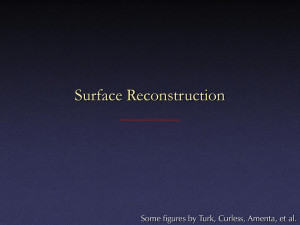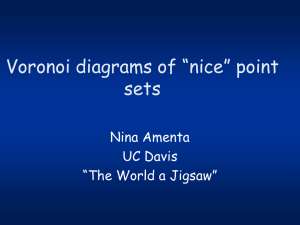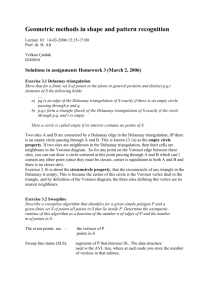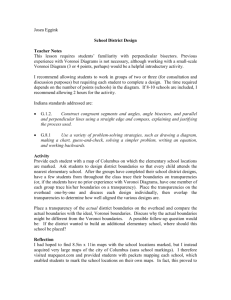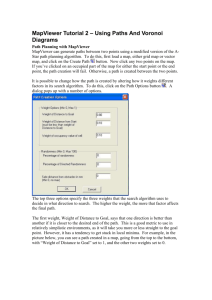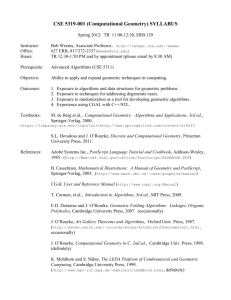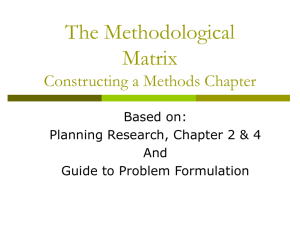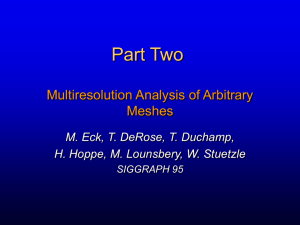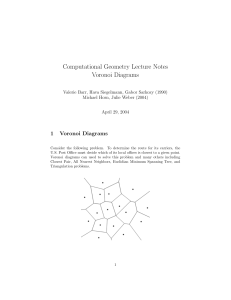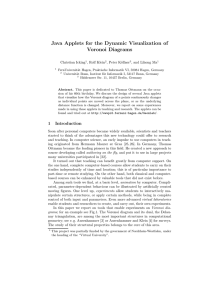MA 323 Geometric Modelling Course Notes: Day 38 David L. Finn
advertisement
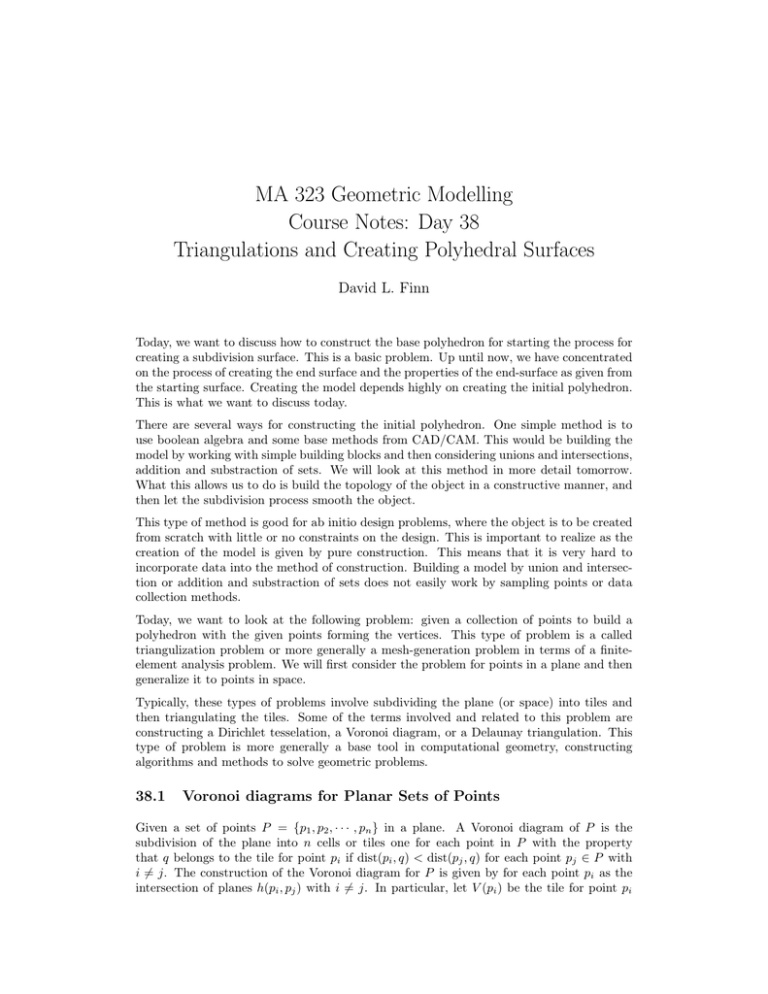
MA 323 Geometric Modelling
Course Notes: Day 38
Triangulations and Creating Polyhedral Surfaces
David L. Finn
Today, we want to discuss how to construct the base polyhedron for starting the process for
creating a subdivision surface. This is a basic problem. Up until now, we have concentrated
on the process of creating the end surface and the properties of the end-surface as given from
the starting surface. Creating the model depends highly on creating the initial polyhedron.
This is what we want to discuss today.
There are several ways for constructing the initial polyhedron. One simple method is to
use boolean algebra and some base methods from CAD/CAM. This would be building the
model by working with simple building blocks and then considering unions and intersections,
addition and substraction of sets. We will look at this method in more detail tomorrow.
What this allows us to do is build the topology of the object in a constructive manner, and
then let the subdivision process smooth the object.
This type of method is good for ab initio design problems, where the object is to be created
from scratch with little or no constraints on the design. This is important to realize as the
creation of the model is given by pure construction. This means that it is very hard to
incorporate data into the method of construction. Building a model by union and intersection or addition and substraction of sets does not easily work by sampling points or data
collection methods.
Today, we want to look at the following problem: given a collection of points to build a
polyhedron with the given points forming the vertices. This type of problem is a called
triangulization problem or more generally a mesh-generation problem in terms of a finiteelement analysis problem. We will first consider the problem for points in a plane and then
generalize it to points in space.
Typically, these types of problems involve subdividing the plane (or space) into tiles and
then triangulating the tiles. Some of the terms involved and related to this problem are
constructing a Dirichlet tesselation, a Voronoi diagram, or a Delaunay triangulation. This
type of problem is more generally a base tool in computational geometry, constructing
algorithms and methods to solve geometric problems.
38.1
Voronoi diagrams for Planar Sets of Points
Given a set of points P = {p1 , p2 , · · · , pn } in a plane. A Voronoi diagram of P is the
subdivision of the plane into n cells or tiles one for each point in P with the property
that q belongs to the tile for point pi if dist(pi , q) < dist(pj , q) for each point pj ∈ P with
i 6= j. The construction of the Voronoi diagram for P is given by for each point pi as the
intersection of planes h(pi , pj ) with i 6= j. In particular, let V (pi ) be the tile for point pi
38-2
and h(p, q) be the open half plane containing p obtaining by bisecting the segment pq by
the perpendicular bisector, see diagram below.
Figure 1: Half-plane h(p, q)
The tile V (pi ) is defined as
V (pi ) = ∩1≤j≤n,
i6=j
h(pi , pj )
see diagram below.
Figure 2: The tile V (pi ) in a Voronoi diagram
This yields a complete Voronoi diagram (or Dirichlet tesselation) that looks like the diagram
below.
Notice in this construction, the points pi lie in the interior of each tile. This is not necessarily
optimal for constructing a polyhedron. Instead, it would convenient if the points in the set
P were the vertices of the polyhedron. This is accomplished by using the Voronoi diagram
to construct a triangulization of the point set. First construct the Voronoi diagram, to get
the tiles. Then we construct a triangulization by noting that generically only three bisectors
meet at a point in the Voronoi diagram. We connect two points pi pj if the bisector pi pj is
an edge of the tile V (pi ) and V (pj ). This forms a triangulization of the point set. This is
called the Delaunay triangulization of the point set P , see diagram below.
38-3
Figure 3: A Voronoi diagram
Figure 4: A Delaunay triangulation
There are exceptions to the above type of triangulization. We will not discuss these exceptions in great detail. This is important in computational geometry, but for our purposes
can be avoiding by tweaking the data points.
38.2
Voronoi Diagrams in Space
To construct a triangulation for a collection of points P = {p1 , p2 , · · · , pn } in space, we
first note that the construction of a Voronoi diagram proceeds as before using half-spaces
instead of half-planes. The construction of the Delanauy triangulation is more complicated.
In principal, it is done the same connecting two points pi and pj if the tiles share a face.
Except that they should not always be connected to form a polyhedral surface.
One method for constructing a Voronoi diagram is to project a subcollection of points onto
a plane. Construct a Voronoi diagram for the projection to create a triangulation for the
projection, and then lift the triangulation for the projection to the spatial points. The
38-4
triangulations and then overlayed together as a collection of local triangulations and then
fitted together to form a global triangulation, see diagrams below for constructing one.
! " Figure 5: Constructing a triangulation for points on a surface
This works in general well for points on a surface, as points should be close to a plane at least
when viewed in a small enough region. However it runs into some problems as the numbers
may have to be large in order to effectively generate a mesh so the notion of closeness will
easily work for projection. Luckily, most objects to be generated are sufficiently nice the
topology of a sphere, and normally not too complicated.
38-5
Figure 6: Construct Voronoi diagram and Delaunay triangulation
Exercies
1. Given the collection of points below, sketch the Voronoi diagram and the Delaunay
triangulation. Ignoring points at infinity.
